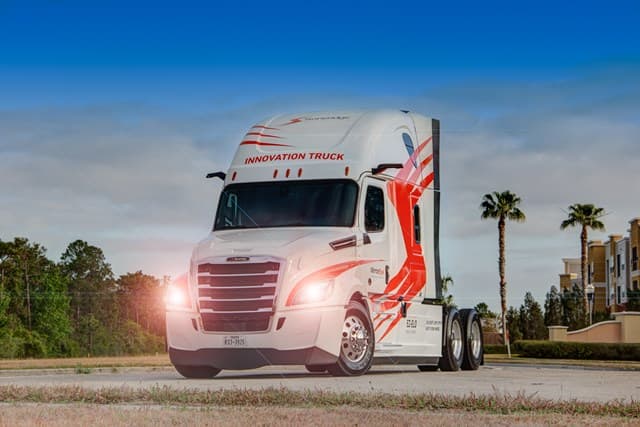WASHINGTON — The Federal Motor Carrier Safety Administration has approved an exemption application from Stoneridge Inc. that will allow the company’s MirrorEye Camera Monitor System (CMS) to be installed as an alternative to conventional rear-vision mirrors currently required on commercial motor vehicles in the United States.
The decision will apply solely to Stoneridge’s MirrorEye system, making it the only CMS that allows for complete removal of traditional mirrors in the U.S., said a Stoneridge news release.
“This decision will help bring an innovative driver vision technology to market that will greatly improve the safety of everyone who shares the road,” said Jon DeGaynor, Stoneridge president and CEO. “The MirrorEye Camera Monitor System empowers truck drivers to avoid potential collisions by the elimination of certain blind spots, expansion of their field of view and increased awareness of the truck’s surroundings. This exemption allows our customers to fully recognize both the safety and fuel economy benefits of MirrorEye.”
In granting the exemption, FMCSA noted the MirrorEye CMS consists of multiple digital cameras mounted on the exterior of the CMV and enclosed in an aerodynamic package that provides both environmental protection for the cameras and a mounting location for optimal visibility.
FMCSA said each camera has video processing software that presents a clear, high-definition image to the driver by means of a monitor mounted to each A-pillar of the CMV, i.e., the structural member between the windshield and door of the cab.
The agency said Stoneridge explained in its exemption request that attaching the monitors to the A-pillars avoids the creation of incremental blind spots while eliminating the blind spots associated with conventional mirrors.
Stoneridge told FMCSA that its technology meets or exceeds the visibility requirements provided in federal trucking regulations based on several factors:
- Greater field of view than conventional mirrors. Mirrors are replaced by wide angle, narrow angle and look-down cameras, expanding the field of view by an estimated 25 percent.
- Fail-safe design. The system has independent video processing of multiple camera images so that in the unlikely event of an individual camera failure, the other camera images continue to be displayed, ensuring that real-time images are displayed without interruption.
- Augmented and enhanced vision quality. The use of high-definition digital cameras provides for color night vision, low light sensitivity and trailer panning capabilities. This assists with night driving, operating under other low lighting conditions, and provides for glare reduction.
- Trailer panning. The CMS automatically tracks the end of the trailer to keep it in view while the vehicle is moving forward. Stoneridge believes this feature could eliminate collisions associated with the CMV driver making a right-hand turn, and incidents where the CMV strikes a pedestrian or bicyclist while making right-hand turns.
DeGaynor thanked trucking industry leaders who have tested, provided input and helped validate the effectiveness and reliability of the technology.
“Stoneridge would like to especially acknowledge the American Trucking Associations, Truckload Carriers Association, Trucking Alliance, Spangenberg Partners and numerous individuals of the trucking community who have supported our mission of improved safety,” he said.
Last April, FMCSA said it had asked for public comments on the exemption request.
ATA told the agency that granting this and similar petitions for exemption from federal requirements that currently are barriers to mirrorless technology would provide valuable real-world experience and data to inform future regulatory action to allow CMS technology as an alternative to rear view mirrors for all vehicle types, noting that motor carriers and truck manufacturers recognize the potential of CMS to improve both safe operations and fuel efficiency when compared with traditional exterior mirrors.
Schneider and J.B. Hunt both told FMCSA they had been using the MirrorEye CMS, in addition to the required mirrors, in a select number of vehicles.
“Both motor carriers support granting Stoneridge’s application,” FMCSA said in granting the exemption.
“Schneider states that its drivers using the MirrorEye CMS have (1) had an overwhelmingly positive experience,” and (2) confirmed some of the benefits touted by Stoneridge in its application, including improved visibility in night driving and low-light conditions, improved visibility due to auto tracking of the trailer, and reduced driver distraction due to light and glare reduction.”
J.B. Hunt commented that “we have not been involved in any collisions and have received overwhelming positive feedback from our test drivers,” adding that its drivers noted benefits such as “real time, excellent monitor image clarity with improved field of vision around their tractors and trailing units and elimination of the tractor’s problematic front passenger side blind spot.”
The FMCSA said Advocates for Highway and Auto Safety had opposed the exemption request “on the basis that the application is overly broad,” noting that the regulations governing requests for exemption require applications to include “an estimate of the number of drivers and commercial motor vehicles that would be operated under the terms and conditions of the exemption,” which in this case could encompass every CMV and driver presently on the U.S. roads.
“We must oppose such an overly broad exemption which would apply for at least five years,” Advocates said in its comment.
The organization added that while opposed to the application, it recognized the potential benefits of the technology, and instead urged the National Highway Traffic Safety Administration and FMCSA “to establish a pilot program study the benefits of using cameras to enhance commercial vehicle driver visibility as this technology has the potential to reduce or eliminate the large and dangerous blind zones around CMVs.”
“MirrorEye technology was designed and improved based on real input from commercial vehicles drivers during testing,” said Stephen Fox, vice president of business development at Stoneridge. “We have collected a tremendous amount of data and challenged the system in real-life scenarios. We are fully confident MirrorEye CMS will provide exceptional reliability and resolve many of the safety issues commercial vehicle drivers currently face.”
The Trucker News Staff produces engaging content for not only TheTrucker.com, but also The Trucker Newspaper, which has been serving the trucking industry for more than 30 years. With a focus on drivers, the Trucker News Staff aims to provide relevant, objective content pertaining to the trucking segment of the transportation industry. The Trucker News Staff is based in Little Rock, Arkansas.














